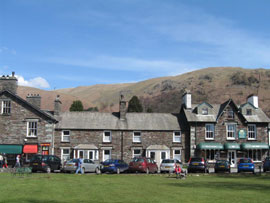Why is Grasmere village special?
Grasmere is a historic village by the River Rothay with attractive architectural and historic character. This includes:

- Origins as a settlement that perhaps dates to the early medieval period, with a church dedicated to St Oswald, the seventh century king of Northumbria.
- Development as a centre of water-powered textile industries in the later medieval period.
- Role as a focal point for Lake District tourism following the construction of metalled roads from the 1770s and railways from the 1840s.
- International significance as a centre for Wordsworth heritage, based on the several houses in the parish in which William Wordsworth lived, and on the graves of the Wordsworth family in Grasmere churchyard.
- Numerous large purpose-built hotels as testimony to the nineteenth century tourist industry that Wordsworth did so much to inspire.
- Amphitheatre-like setting in a plain surrounded by high rugged fells.
- Expansive views across the level plain to the fells.
- The large open green spaces within the village, with meadows that come right into the centre of the village.
- Grass verges and field walls along the lanes, enhancing the relationship between Grasmere and the surrounding landscape.
- Numerous trees, whose foliage gives Grasmere the distinctive appearance of a woodland settlement.
- The contribution of the River Rothay, which creates a natural boundary to the village, and whose banks have been a focal point for building and industry, as well as adding great scenic interest to the village, with its historic and modern bridges and its riverside paths.
- The network of public footpaths linking the village to the river and to the surrounding countryside.
- The quality and homogeneity of the historic buildings, with good examples of both common and rare Lakeland vernacular architecture, historic shop fronts and larger gentry houses and hotels including 11 listed buildings.
- The palette of building materials reflecting the underlying geology of dark grey and purple slate stone, with contrasting blue grey detailing for quoins, window and door surrounds, drip moulds and chimneys.
- The number and variety of activities supported by the village, which is a busy commercial centre with school, theatre, social clubs.
More details
